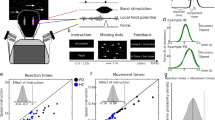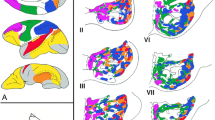Abstract
We used positron emission tomography (PET) to compare the contribution of the cerebellum and basal ganglia to the sensory guidance of movement. In one condition the subjects used a computer mouse to draw a series of lines on a computer screen (DRAW). In the second condition the same lines were presented to the subjects, and they had to track the lines with a mouse pointer on the screen (COPY). In a third condition the subjects were again presented with the same lines, and they simply followed movements of the pointer with their eyes (EYES). In the fourth condition, the subjects fixated a central point, ignoring the sequence of presented lines (FIX). The pons and cerebellum were activated more during visually guided tracking than in freely generated drawing (COPY vs DRAW). The basal ganglia were activated equally in both DRAW and COPY. The prefrontal and inferior temporal cortex were activated more when subjects drew lines freely (DRAW) than when they copied them (COPY). We conclude that the cerebellum is specialized for using sensory information to correct movements, but that the basal ganglia are involved both in movements that are self-generated and in movements that are guided by external cues.
Similar content being viewed by others
References
Alexander GE (1987) Selective neuronal discharge in monkey putamen reflects intended direction of planned limb movements. Exp Brain Res 67:623–634
Anderson TJ, Jenkins IH, Brooks DJ, Hawken MB, Frackowiak RSJ, Kennard C (1994) Cortical control of saccades and fixation in man: a PET study. Brain 117:1073–1084
Berretta S, Perciavalle V, Poppele RE (1991) Origin of spinal projections to the anterior and posterior lobes of the rat cerebellum. J Comp Neurol 305:273–281
Bosco G, Poppele RE (1993) Broad directional tuning in spinal projections to the cerebellum. J Neurophysiol 70:863–866
Brooks DJ (1995) The role of the basal ganglia in motor control: contributions from PET. J Neurol Sci 128:1–13
Buerger AA, Gross CG, Rocha-Miranda CE (1974) Effects of ventral putamen lesions on discrimination learning. J Comp Physiol Psychol 86:440–446
Buswein E, Kolb FP, Leimbeck B, Rubia FJ (1983) Simple and compley spike activity of cerebellar Purkinje cells during active and pasive movements in the awake monkey. J Physiol (Lond) 339:379–394
Connor NP, Abbs JH (1990) Sensorimotor contributions of the basal ganglia: recent advances. Phys Ther 70:864–872
Crutcher MD, DeLong MR (1984) Single cell studies of the primate putamen. I. Functional organization. Exp Brain Res 53:233–243
Deiber M-P, Passingham RE, Colebatch JG, Friston KJ, Nixon PD, Frackowiak RSJ (1991) Cortical areas and the selection of movement: a study with positron emission tomography. Exp Brain Res 84:393–402
Flaherty AW, Graybiel AM (1993) Two input systems for body representations in the primate striatal matrix: experimental evidence in the squirrel monkey. J Neurosci 13:1120–1137
Flowers KA (1976) Visual “closed loop” and “open loop” characteristics of voluntary movement in patients with Parkinsonism and intention tremor. Brain 99:269–310
Flowers KA (1978) Lack of prediction in the motor behaviour of Parkinsonism. Brain 101:35–52
Friston KJ, Passingham RE, Nutt JG, Heather JD, Sawle GV, Frackowiak RSJ (1989) Localisation in PET images: direct fitting of the intercommissural (AC-PC) line. J Cereb Blood Flow Metab 9:690–695
Friston KJ, Frith CD, Liddle PF, Dolan RJ, Lammertsma AA, Frackowiak RSJ (1990) The relationship between global and local changes in PET scans. J Cereb Blood Flow Metab 10:458–466
Friston KJ, Frith CD, Liddle PF, Frackowiak RSJ (1991) Comparing functional (PET) images: the assessment of significant change. J Cereb Blood Flow Metab 11:690–699
Frith CD, Friston K, Liddle PF, Frackowiak RS (1991) Willed action and the prefrontal cortex in man: a study with PET. Proc R Soc Lond B 244:241–246
Glickstein M, May JG, Mercier RE (1985) Corticopontine projections in the macaque: the distribution of labelled cortical cells after large injections of horse-radish peroxidase in the pontine nuclei. J Comp Neurol 235:343–359
Goldberg G (1985) Supplementary motor area structure and function: review and hypotheses. Exp Brain Res 8:567–588
Grady CL, Maisog JM, Horwitz B, Ungerleider LG, Mentis MJ, Salerno J, Pietrini P, Wagner E, Haxby JV (1994) Age-related changes in cortical blood flow activation during visual processing of faces and location. J Neurosci 14:1450–1462
Grafton ST, Mazziotta JC, Presty S, Friston KJ, Frackowiak RS, Phelps ME (1992) Functional anatomy of human procedural learning determined with regional cerebral blood flow and PET. J Neurosci 12:2542–2548
Grafton ST, Woods RP, Tyszka M (1994) Functional imaging of procedural motor learning: relating cerebral blood flow with individual subject performance. Hum Brain Mapping 1:221–234
Grill SE, Hallett M, Marcus C, McShane L (1994) Disturbances of kinaesthesia in patients with cerebellar disorders. Brain 117:1433–1447
Hikosaka O, Wurtz RH (1983) Visual and oculomotor function of monkey substantia nigra pars reticulata. III. Memory-contingent visual and saccade response. J Neurophysiol 49:1230–1253
Hoesen G van, Yeterian EH, Lavizzo-Mourey R (1981) Widespread corticostriate projection from temporal cortex of the rhesus monkey. J Comp Neurol 199:205–219
Ito M (1984) The cerebellum and neural content. Raven Press, New York
Jahanshahi M, Jenkins IH, Passingham RE, Brown RG, Marsden CD, Brooks DJ (1995) The effect of context on volitional actions: evidence from recording movement-related potentials and measurement of regional cerebral blood flow with PET. Brain 118:913–933
Jenkins IH, Brooks DJ, Nixon PD, Frackowiak RSJ, Passingham RE (1994) Motor sequence learning: a study with positron emission tomography. J Neurosci 14:3775–3790
Kolb FP, Rubia FJ, Bauswein E (1987) Cerebellar unit responses of the mossy fibre system to passive movements in the decerebrate cat. Exp Brain Res 68:234–248
Lang W, Lang M, Podreka I, Steiner M, Uhl F, Suess E, Muller C, Deeke L (1988) DC-potential shifts and regional cerebral blood flow reveal frontal cortex involvement in human visuomotor learning. Exp Brain Res 71:353–364
Lueck CJ, Tanyeri S, Crawford TJ, Henderson L, Kennard C (1990) Antisaccades and remembered saccades in Parkinson's disease. J Neurol Neurosurg Pschiatry 53:284–288
Miall RC, Weir DJ, Stein JF (1987) Visuo-motor tracking during reversible inactivation of the cerebellum. Exp Brain Res 65:455–464
Mikami A, Ito S, Fubota K (1982) Visual response properties of dorsolateral prefrontal cortex neurons during a visual fixation task. J Neurophysiol 47:593–605
Murphy JT, MacKay WA, Johnson F (1973) Differences between cerebellar mossy and climbing fibre responses to natural stimulation of forelimb muscle proprioceptors. Brain Res 55:263–289
Mushiake H, Strick PL (1993) Preferential activity of dentate neurons during limb movements guided by vision. J Neurophysiol 70:2660–2664
Mushiake H, Strick PL (1995) Pallidal neuron activity during sequential arm movements. J Neurophysiol 74:2754–2759
Ojakangas CL, Ebner TJ (1992) Purkinje cell complex and simple spike changes during a voluntary arm movement learning task in the monkey. J Neurophysiol 68:2222–2236
Oldfield RC (1971) The assessment and analysis of handedness: the Edinburgh Inventory. Neuropsychologia 9:97–113
Passingham RE (1993) The frontal lobes and voluntary action. Oxford Science Publications, Oxford
Playford ED, Jenkins IH, Passingham RE, Nutt J, Frackowiak RSJ, Brooks DJ (1992) Impaired mesial frontal and putamen activation in Parkinson's disease: a PET study. Ann Neurol 32:151–161
Romo R, Scarnati E, Schultz W (1992) Role of primate basal ganglia and frontal cortex in the internal generation of movements. II. Movement-related activity in the anterior striatum. Exp Brain Res 91:385–395
Saint-Cyr J, Ungerleider LG, Desimone R (1990) Organization of visual cortical inputs to the striatum and subsequent outputs to the pallido-nigral complex in the monkey. J Comp Neurol 298:129–156
Schmahmann JD, Pandya DN (1989) Anatomical investigation of projections to the basis pontis from posterior parietal association cortices in rhesus monkey. J Comp Neurol 289:53–73
Schmahmann JD, Pandya DN (1991) Projections to the basis pontis from the superior temporal sulcus and superior temporal region in the rhesus monkey. J Comp Neurol 308:224–248
Schultz W, Romo R (1992) Role of primate basal ganglia and frontal cortex in the internal generation of movements. I. Preparatory activity in the anterior striatum. Exp Brain Res 91:363–384
Schwartz BA, Halgren E, Fuster J, Mandelkern M (1994) An 18FGD study of cortical activation during a short-term visual memory task in humans. Neuroreport 5:925–928
Selemon LD, Goldman-Rakic PS (1985) Logitudinal topography and interdigitation of corticostriatal projections in the rhesus monkey. J Neurosci 5:776–794
Seltzer B, Pandya DN (1994) Parietal, temporal, and occipital projections to the cortex of the superior temporal sulcus in the rhesus monkey: a retrograde tracer study. J Comp Neurol 343:445–463
Spinks TJ, Jones T, Bailey DL, Townsend DW, Grootoonk S, Bloomfield PM, Gilardi M-C, Casey ME, Sipe B, Reed J (1992) Physical performance of a positron tomograph for brain imaging with retractable septa. Phys Med Biol 8:1637–1655
Stein J, Miall RC, Weir D (1987) The role of the cerebellum in the visual guidance of movements. In: Glickstein M, Yeo C, Stein J (eds) Cerebellum and Neuronal Plasticity, Plenum, New York, pp 175–191
Stein JF, Glickstein M (1992) Role of the cerebellum in visual guidance of movement. Physiol Rev 72:976–1015
Talairach J, Tournoux P (1988) Co-planar stereotaxic atlas of the human brain. Thieme, New York
Thach WT, Goodkin HP, Keating IG (1992) The cerebellum and the adaptive coordination of movement. Annu Rev Neurosci 15:403–442
Townsend DW, Geissbuhler A, Defrise M, Hoffmann EJ, Spinks TJ, Bailey DL, Gilardi M-C, Jones T (1991) Fully three-dimensional reconstruction for a PET camera with retractable septa. IEEE Trans Med Imaging 10:505–512
Ungerleider LG, Desimone R, Galkin T, Mishkin M (1984) Subcortical projections of area MT in the macaque. J Comp Neurol 223:368–386
Ungerleider LG, Gaffan D, Pelak VS (1989) Projections from inferotemporal cortex to prefrontal cortex via the uncinate fascicle in rhesus monkeys. Exp Brain Res 76:473–484
Wichmann T, Bergman H, DeLong MR (1994) The primate subthalamic nucleus. J Functional properties in intact animals. J Neurophysiol 72:494–506
Woods RP, Cherry SR, Mazziotta JC (1992) Rapid automated algorithm for aligning and reslicing PET images. J Comput Assist Tomogr 16:620–633
Author information
Authors and Affiliations
Rights and permissions
About this article
Cite this article
Jueptner, J., Jueptner, M., Jenkins, I.H. et al. The sensory guidance of movement: a comparison of the cerebellum and basal ganglia. Exp Brain Res 112, 462–474 (1996). https://doi.org/10.1007/BF00227952
Received:
Accepted:
Issue Date:
DOI: https://doi.org/10.1007/BF00227952




